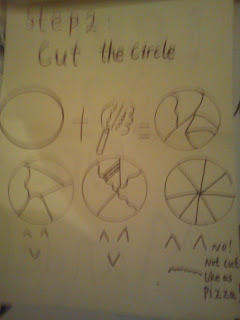1.The structure and timings of session (25 minutes)
 The introduction to the Mandala and meaning in spirit and internal express(3 minutes).
The introduction to the Mandala and meaning in spirit and internal express(3 minutes). Create a placid and peaceful environment together through abdominal breathing ( 5 minutes).
Create a placid and peaceful environment together through abdominal breathing ( 5 minutes). To teach and practice drawing a Mandala(15 minutes)
To teach and practice drawing a Mandala(15 minutes)  Learners communicate with each other by language expression and art expression.(2 Minutes)
Learners communicate with each other by language expression and art expression.(2 Minutes)2.Learning Aims
 Introduce the basic knowledge and information to the Mandala and the relation to between Mandala with the exhibition’s topic.
Introduce the basic knowledge and information to the Mandala and the relation to between Mandala with the exhibition’s topic. Introduce the abdominal breathing Exercises and be able to practice it.
Introduce the abdominal breathing Exercises and be able to practice it. Learn and done a Zentangle Mandala together
Learn and done a Zentangle Mandala together3.Learning Outcome
 Understand the knowledge and information about Mandala.
Understand the knowledge and information about Mandala. Know how to use abdominal breathing to clear our mind and relax.
Know how to use abdominal breathing to clear our mind and relax.  Used by the creativity and facture done a pieces of Zentangle mandala.
Used by the creativity and facture done a pieces of Zentangle mandala. Develop communication skills to express by language and figure.
Develop communication skills to express by language and figure.  The word ‘mandala’ is from the classical indian language, it means circle,but not only one simple shape. It represents wholeness, and can be seen as a model for the organizational structure of life itself, it is a cosmic diagram which extends both beyond and within our bodies and minds, or material and non-material world.
The word ‘mandala’ is from the classical indian language, it means circle,but not only one simple shape. It represents wholeness, and can be seen as a model for the organizational structure of life itself, it is a cosmic diagram which extends both beyond and within our bodies and minds, or material and non-material world. The psychoanalyst Carl Jung saw the mandala as a representation of the unknown self and believe the paintings of mandalas enabled him to identify emotional disorders and work towards wholeness in personality. It can be used as a vehicle to explore art, science, religion and life itself, the mandala contains an encyclopedia of the finite and a road map to infinity.
The psychoanalyst Carl Jung saw the mandala as a representation of the unknown self and believe the paintings of mandalas enabled him to identify emotional disorders and work towards wholeness in personality. It can be used as a vehicle to explore art, science, religion and life itself, the mandala contains an encyclopedia of the finite and a road map to infinity. Creating a group mandala is a unifying experience to people can express themselves individually within a unified structure.
Creating a group mandala is a unifying experience to people can express themselves individually within a unified structure. The mandala pattern is used in many religious traditions and different cultures, and could to cross cultural block to demonstrate the impermanence of life.
The mandala pattern is used in many religious traditions and different cultures, and could to cross cultural block to demonstrate the impermanence of life. The excellent drawing skill isn’t necessary for to drawing a simple Mandala, so anybody could to done one Mandala in no more than half hour.
The excellent drawing skill isn’t necessary for to drawing a simple Mandala, so anybody could to done one Mandala in no more than half hour. It is a effective relaxation to tune up autonomic nerve system of our boday, transfor a stressful, angry and agitated life into a calm, peaceful and relaxed life. This breathing exercise has a strengthening effect on the spine and brings peacefulness into the mind.
It is a effective relaxation to tune up autonomic nerve system of our boday, transfor a stressful, angry and agitated life into a calm, peaceful and relaxed life. This breathing exercise has a strengthening effect on the spine and brings peacefulness into the mind.Step 1.Sit down with the spine properly supported
Step. 2 Put two hands on your belly.
Step. 3 Look ahead and Drop your shoulders, relax yourself and closed your eyes.
Step. 4 Deeply Breathe in the muscles and feeling bigger and bigger belly.
Step. 5 Relax and breathe out the muscles and feeling smaller and smaller belly
reference:
 http://www.youtube.com/watch?v=tR2yR_uYUlc&feature=related
http://www.youtube.com/watch?v=tR2yR_uYUlc&feature=related7.To teach and practice drawing a Mandala(15 minutes)
Step 1: Use the bottom of a cup to copy a circle
Step 2: Cut the circle
Step 3: Take you pick of these flower patters
The examples of flower patters
8.Learners communicate with each other by language expression and art expression








No comments:
Post a Comment